Explore The Bill Dobbins Female Physique Webzine/Gallery
IFBB OLYMPIA WEEKEND 2004
WOMEN'S BODYBUILDING, FITNESS AND FIGURE
COMPETITION REPORTS
By Bill Dobbins

INTRODUCTION
The IFBB has been combining the women's
Olympia competition with that of the men in Las Vegas, at the Mandalay
Bay, since 2000. It has
been largely successful, with a substantial crowd – although not
a sell out – regularly showing up on Friday night to see the women
compete. The ticket sales for the women at the Olympia, and the crowds
attending the women's events at the Arnold Weekend in Columbus each year,
have done much to show that a considerable audience exists for female muscle,
despite the claim to the opposite by many critics of women's physique.
Unfortunately, the audience at the Mandalay Bay seemed to be considerably smaller this year. Since there is no reason to believe there is suddenly less interest in the women than in the past, the cause for lackluster attendance must have something to do with the way the competition was promoted and publicized for 2004.
In fact, there have been considerable changes regarding the Olympia in the past year. American Media, the publishing powerhouse that also owns the Florida tabloids, and which recently purchased Weider Publications, this year acquired a half interest in the Olympia Weekend from the IFBB – and longtime IFBB promoter Wayne Demilia was replaced for 2004 by a group from Weider. Jumping into such a huge undertaking with limited experience is bound to result in at least some mistakes. A lack of publicity and promotion – especially involving the women – might well be one of them.
Hopefully, American Media will not be discouraged by problems encountered, will simply take them as part of the learning curve involved in organizing such a complex series of events and will not take what seemed to be slow ticket sales for the women's contests as any reason not to continue to support female bodybuilding, fitness and figure in the future.
PHOTOGRAPHY
 One word about the stage photos (found
in large quantities in the subscriber area): as far as the photographers
were concerned, the
situation at the
finals was extremely difficult. We were situated a considerable distance
from the stage and positioned behind the judges. When the men competed
on Saturday, they stood on raised platforms. The women did not. As
a result, along with having to use long lenses to shoot anyone on the stage,
it was almost impossible to get wide shots of the stage or even full length
photos of the competitors without include a view of somebody's head – or
several heads.
One word about the stage photos (found
in large quantities in the subscriber area): as far as the photographers
were concerned, the
situation at the
finals was extremely difficult. We were situated a considerable distance
from the stage and positioned behind the judges. When the men competed
on Saturday, they stood on raised platforms. The women did not. As
a result, along with having to use long lenses to shoot anyone on the stage,
it was almost impossible to get wide shots of the stage or even full length
photos of the competitors without include a view of somebody's head – or
several heads.
Of course, initially it looked as if many of us would not receive press credentials at all. So any photos are better than none. But it was also impossible for any but Weider photographers to shoot backstage – and Weider magazines are not likely to run many photos of women pumping up or in the dressing rooms.
Suggestion: if you want to sell tickets to the Friday night contests at the Olympia, the women need more promotion and publicity. This involves (1) more coverage in the magazines, (2) backstage and pumping up photos available to other magazines and websites and (3) better conditions for the photographers shooting the stage.
Publicity sells tickets and magazines. Lack of publicity doesn't. From a business point of view this seem pretty much a no-brainer.
MS. OLYMPIA BODYBUILDING
BACKGROUND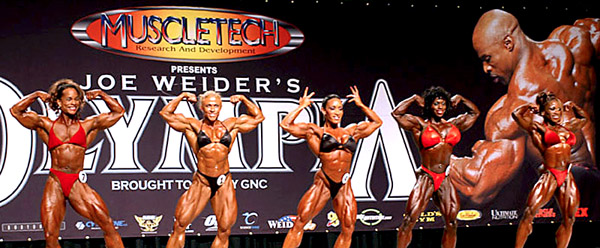
One thing apparent in looking at the line-ups at the 2004
Ms. Olympia is that, while the men continue to get bigger and more massive
every year,
the same thing is not happening
with the women. The biggest women this in the contest this year were
about 160-165 lbs, which was Kim Chizevsky's size when she competed in
the late 1990s.
One thing that characterizes a sport is that it continues to make progress – such as increases in things like faster, higher, stronger, or bigger. But this progress is not uniform. You tend to see faster gains in the beginning and this then slows down as you begin to approach genetic limits – and you encounter the law of diminishing returns. Slowing down of progress this way tends to be the sign of a "mature" sport.
So why haven't the women bodybuilders – who are involved in a very new sport - been making regular and substantial progress in terms of physical development? The most plausible explanation involves the negative influence of IFBB and NPC policies plus the lack of appreciation and support by the physique magazines. Male bodybuilders are constantly striving to get bigger, harder and more defined, to increase size, shape and muscularity. That is the nature of bodybuilding and the men are rewarded for it. But female bodybuilders are not (in general) trying to achieve the same degree of excellence. They are afraid of being marked-down by the judges and subjected to negative comments by critics of female muscle and the bodybuilding media. They are like women sprinters being told not to run "too fast" or risk disqualification.
Not only are female bodybuilders currently in the sport reluctant to develop to their genetic potential, but many women who could be excellent bodybuilders opt instead for fitness, figure or not to compete at all. As a result the "genetic pool" for women's bodybuilding is much more limited than it should be. Sadly to say, many a potential Rachel McLish, Cory Everson or Lenda Murray will never end up competing on a bodybuilding stage.
And those who do compete find it increasingly hard to make any money as professional bodybuilders – because of lack of prize money, endorsements, sponsors or guest posing opportunities. Bodybuilding is just too difficult to do well for competitors to have to cope with the added burden on constant opposition and discouragement.
Nonetheless, in spite of these unfortunate limitations being imposed on the sport the best are still pretty damn good. It would be hard to imagine a more sensual package at 129 pounds than Dayana Cadeau, a more shapely female physique than Lenda Murray or a more complete package than Iris Kyle.
So women's bodybuilding is obviously alive and well, has outstanding competitors and a loyal fan base – it's just that nobody has bothered to explain this to the federations and the magazines. Or, more likely, they've been told but just aren't listening. Female bodybuilding has a bright future – as long as the powers-that-be don't insist on killing it with self-fulfilling prophecies.
WEIGHT DIVISIONS
One problem we continue to see
at both the Ms. Olympia and the Ms. International is the use of two weight
divisions instead of three. The lightweight
cut-off is 135 pounds. This means that an outstanding 121 lb physique
has to stand next to a competitor weighing 135 lbs – which with women
this size is a huge difference. It also means that 136 lb women have
to go up against women 20 or 30 lbs larger (or potentially even heavier
competitors).
The limit for heavyweight has to be raised and a genuine middleweight division created between the smaller, legitimate lightweights and the larger heavyweight competitors.
The idea of weight divisions involved (1) allowing smaller women to compete successfully as pros and (2) to discourage women pros from "bulking up" and gaining too much weight in an attempt to compete against much larger opponents. But using only two weight divisions to limit the number of competitors, the prize money or otherwise for the convenience of the promoters is a mistake.
In fact, one of the major problems with men's pro bodybuilding is the lack of weight divisions. The IFBB is concerned with the perception of bodybuilding on the part of the "general public" and yet their policies result in making it impossible for bodybuilders to win a pro title in major events unless they weight something close to 300 lbs! Now that American Media has taken an interest in IFBB bodybuilding perhaps they can influence the federation to institute weight divisions in men's pro bodybuilding and to allow the women pros to compete in three divisions instead of two.
THE LIGHTWEIGHTS
For the past three years, the
winner of the lightweight class of the Ms. Olympia was Juliette Bergmann – who switched from being an Olympia
judge to an Olympia competitor to take advantage of the institution of
weight divisions in the sport. This year the class was opened up
for new blood by Juliette's return to retirement – and to the judging
panel officiating at the Olympia.
Only in bodybuilding.
The favorite in the class this year was without a doubt Dayana Cadeau, winner of her class at the Ms. International and runner-up to Juliette in 2003. Dayana has a "Flex Wheeler-like" symmetry, with (as they say) curves in places others don't even have places, a beautiful face and an extremely "feminine" appearance and manner.
Amazingly, considering the extreme appeal of this entire "package," many physique magazines have been reluctant to publish photo features on Dayana. "Too big," was one criticism expressed – this for a woman weighing less than 130 lbs! "Looks too much like a man," another magazine said. The only answer to this is a gift subscription to "Optometrist Monthly" and a course in basic anatomy.
Certainly, there was nothing too big or unfeminine about Dayana on the stage of the Ms. Olympia 2004. Last year she brought her weight down to 128 lbs, enhancing her symmetry and bringing down the size of her waist. Some bodybuilders lose their shape by losing size, but this was not the case with Dayana. She continued to experiment with changes in size by getting down to 123 lbs for the Arnold. Even though she won her division, it was clear that this was just too light a bodyweight. So for the Olympia she came back up to 129 lbs and ended up winning every round but the posedown.
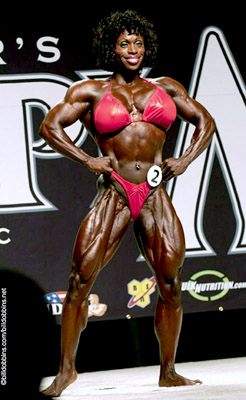 Magazines who don't run photo features on Dayana in the future
are just going to cost themselves sales. There is probably no better
example of sexy, quality female muscle in the sport.
Magazines who don't run photo features on Dayana in the future
are just going to cost themselves sales. There is probably no better
example of sexy, quality female muscle in the sport.
If Dayana's victory was not that much of a surprise, the fact that Denise Masino looked so good and placed second was a pleasant one. Denise has slowly but surely gotten better and better the past few years. Denise was one of those female bodybuilders who backed off in response to the bogus IFBB "guidelines" a few years ago and paid the price. Bodybuilding is like driving a Volkswagen bus up a steep mountain grade. You need to get a running start and keep your foot hard on the gas pedal the whole time. As long as you keep up your momentum you are okay; let up on the throttle or touch the brake and you slow down to the point where it's hard to make any further progress at all.
It took Dense a while to once again "gather momentum" but once she did she has made phenomenal progress. She was third at the Olympia and at the 2004 Ms. International. In the Olympia this year she was not that many points behind Dayana, which is really saying something. It is also significant that Denise achieves this level of development and conditioning while running a demanding business – publishing Muscle Elegance magazine and creating a line of videos.
So much for bodybuilders who complain they can't handle both full-time work and competition training/diet.
Marja Lehtonen of Finland was third. Marja has an incredible amount of solid muscle and, in fact, was the biggest woman in the class. What she needs to more "refinement" – that is to chisel what she has into a diamond-like sculpture. If she is able to do this no doubt she can place higher in the future.
The rest of the placings in the lightweight class were not surprising. Nancy Lewis finishing fourth after winning the GNC was no doubt due in part to her facing tougher competition but also the difficulty of trying to turn around and compete again in a just a couple of weeks. Since getting in shape for bodybuilding is the hardest thing sports (never mind hitting a big-league curve ball) doing it twice in a month is almost impossible. The same can be said for Joanna Thomas, who faced the same dilemma.
One disappoint in the class was Valentina Chepiga finishing down in eighth place. Valentina has won an Olympia title in the past (as a heavyweight in 2000) and has one of the most aesthetic physiques in the sport – a kind of female Frank Zane. In many ways Valentina is just what the IFBB and the magazines say they want: a female bodybuilder with lean, attractive muscle and a pretty face. But Valentina needs a little more solid muscle in order to remain competitive.
But there doesn't seem to be much rush on the part of magazines who say this is the kind of female physique they are looking for to publish photos of her. If the federations and the magazines say what the sport needs is more "presentable" female bodybuilders, perhaps they should back up their convictions by promoting and publicizing attractive women like Valentina.
THE HEAVYWEIGHTS
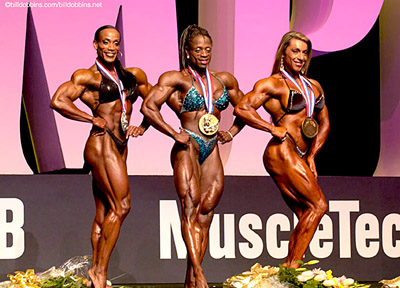 Over the past few years the heavyweight
division has been a battle between Lenda Murray, super-symmetrical, a
great poser and 8-time Ms.
Olympia winner
and Iris Kyle, lacking in such extreme aesthetics and presentation skills,
but possessing a complete physique – and especially outstanding legs
and calves.
Over the past few years the heavyweight
division has been a battle between Lenda Murray, super-symmetrical, a
great poser and 8-time Ms.
Olympia winner
and Iris Kyle, lacking in such extreme aesthetics and presentation skills,
but possessing a complete physique – and especially outstanding legs
and calves.
Iris has been grossly overlooked in the past. One year she wasn't even compared with the top three in her class. But in 2003 she looked like she had the edge in the physique department. Unfortunately for Iris, although Lenda was somewhat lacking in leg development, her conditioning was superb and her posing routine was one of the best EVER in women's bodybuilding. Iris made her own chances worse by a posing routine that consisted mainly of a few compulsory poses and was directed too often to audience members at the side of the theater rather than the judges.
But 2004 was to be Iris' year. She was in her usual excellent shape
(she's only missed once in her pro career as far as I recall) and while
her posing routine was not particularly dynamic it at least looked as if
she were trying. Lenda, on the other hand, was not in as good condition
as the previous year, her legs looked comparatively weak and her posing – while
good – was not at the level if was in 2003.
You could see in Lenda's manner – both on stage and in her backstage interviews (broadcast to the audience via the video screens above the stage) that she was aware that Iris might take the title from her. The scores later revealed that Iris had won three out of the four rounds, and only been behind by a single point in the round in which Lenda came out on top.
Iris Kyle has been a superior bodybuilder for a long time and was bound to win this title eventually, as long as the judging was accurate and honest. The question remains as to what she is going to do now. Iris has avoided publicity in the past, demanding photographers pay her for editorial shoots where nobody else (including Lenda) was getting a fee for doing pictures and not been very outgoing to other competitors, bodybuilding officials or the press.
Let's hope this victory convinces Iris to come out of her shell to some degree and to work at promoting herself and women's bodybuilding. Otherwise we are going to find that a bodybuilding for women goes from a sport where publicity and promotion goes from difficult to impossible.
But Iris and Lenda were not the only outstanding heavyweights in the class by any means. Third was Yaxeni Oriquen, who continues to be a major factor in bodybuilding for women. Yaxeni lacks a certain degree of gem-like sculptural detail that characterizes the best female bodybuilders, but she isn't that far off. She is one of the bigger women in the sport, has a complete physique, comes off as very attractive and dynamic on stage (and caused several observers in the press area to voice the opinion that perhaps she should have been second in the class rather than third).
Actually, the need for "refinement" characterized a number of the competitors in the heavyweight division. For example, Lisa Aukland comes into shows looking very muscular and generally in excellent shape. What she lacks is that same kind of sculptural detail – the quality to go with the size and conditioning. She's already an excellent bodybuilder. This attention to refinement could make her even better.
In the case of Betty Viana and Bonny Priest, the kind of refinement they need is just to come into competition in better shape. For Bonny, a recent pro, this is just a matter of experience and getting it all together. But Betty has been in super shape for pro competition – just not lately. She's got everything else – an excellent physique, a nice face, good posing ability. But for some reason she is not peaking correctly for competition and she won't be winning major pro tiles until she learns to do this every time she hits the stage.
THE OVERALL
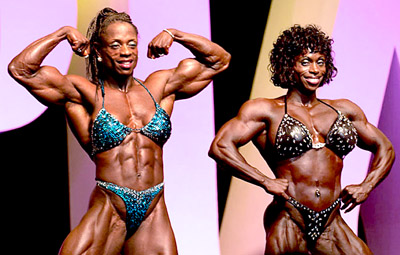 As
usual, the heavyweight beat the lightweight for the overall title. As
soon as Iris and Dayana hit the stage the judges began marking and turning
in their scoresheets. It wasn't just size: standing next to Iris
you could see some of Dayana's proportional problems as well – not
major enough to cause her to lose her class but small things made more
obvious when standing next to the complete and bigger physique of Iris
Kyle - particularly the difference in legs.
As
usual, the heavyweight beat the lightweight for the overall title. As
soon as Iris and Dayana hit the stage the judges began marking and turning
in their scoresheets. It wasn't just size: standing next to Iris
you could see some of Dayana's proportional problems as well – not
major enough to cause her to lose her class but small things made more
obvious when standing next to the complete and bigger physique of Iris
Kyle - particularly the difference in legs.
But all things considered, from the judging standpoint the Ms. Olympia was a considerable success. The class winners and standings as well as the overall were reasonable and acceptable to the competitors, press and the audience. Given the difficulties promoting pro women's bodybuilding in general, it's good to have a Ms. Olympia that is not burdened with controversy.
FITNESS OLYMPIA
Fitness seems pretty much on its way out in both the NPC and IFBB. At
the amateur level, women are quitting NPC fitness for 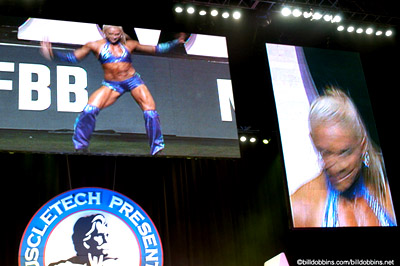 figure in huge numbers. Fitness
routines are seen as difficult and entering figure is viewed as comparatively
easy (although it turns out not to be, since figure is genetically determined
to such a large degree).
figure in huge numbers. Fitness
routines are seen as difficult and entering figure is viewed as comparatively
easy (although it turns out not to be, since figure is genetically determined
to such a large degree).
In 2005, fitness is being dropped from the NPC USA Championships in favor of figure – which gets more women on stage (and paying fees to compete) and cuts down considerably on the time involved in the competition (no sitting through dozens of routines). The IFBB now features a number of pro figure contests that don't include fitness.
At the Fitness Olympia, while the quality of the competitors was high, there was not much in the way of new blood. And has fewer amateurs compete to become pros this is likely to continue. The winner of the show was Adela Garcia-Friedmansky, who has certainly paid her dues over the years and whose physique has continued to get better – meaning she has developed muscle that has filled-out and improved her overall shape.
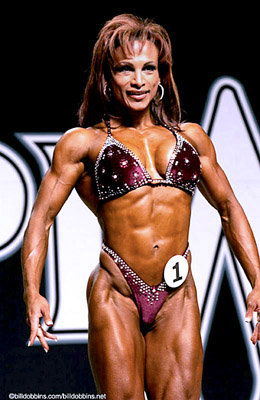 Fitness and figure are both alternate forms of bodybuilding, although
the judges sometimes seem to forget this. But in fitness more than
figure what does best on stage (with some glaring, inexplicable exceptions)
is a physique that looks like a scaled-down lightweight bodybuilder. Adela
has gradually developed a body that conforms more to this standard.
Fitness and figure are both alternate forms of bodybuilding, although
the judges sometimes seem to forget this. But in fitness more than
figure what does best on stage (with some glaring, inexplicable exceptions)
is a physique that looks like a scaled-down lightweight bodybuilder. Adela
has gradually developed a body that conforms more to this standard.
But while Adela's performance routine is energetic and entertaining, she doesn't have the gymnastic skills of second place Jenny Hendershott or Kelly Ryan, who placed third. Judges in amateur shows are beginning to score performances that are not so oriented toward gymnastics somewhat higher, but this doesn't happen in the IFBB. Kelly Ryan got the highest performance scores, Jenny next and Adela third. But Adela was higher enough in the physique rounds that she was able to pull out a victory.
As far as physique is concerned, Jenny has looked a little blocky in the past but is showing improvement in her symmetry. Kelly is going too much in the other direction and needs probably to take a step back – especially since the only other competitor in pro fitness who could go up against her in performance was Susie Curry, who has moved to figure.
Actually, as I've often written in the past it can be very difficult
to predict the outcome of  fitness competition – or to say who should have placed where. But in this case the way
the top three finished was not much of a surprise. But as regards
the rest of the lineup, I have no opinion: There are so many excellent
looking fitness women in the pros that - aside from judging their ability
as gymnasts - I have no idea why many placed where they did. Some
of my favorites scored lower in physique than I would have imagined. But
that's why fitness is not bodybuilding, not really predictable and probably
never will be. Such is the nature of fitness judging.
fitness competition – or to say who should have placed where. But in this case the way
the top three finished was not much of a surprise. But as regards
the rest of the lineup, I have no opinion: There are so many excellent
looking fitness women in the pros that - aside from judging their ability
as gymnasts - I have no idea why many placed where they did. Some
of my favorites scored lower in physique than I would have imagined. But
that's why fitness is not bodybuilding, not really predictable and probably
never will be. Such is the nature of fitness judging.
By the way, notice I make no comment on the judging of the "cat-suit" round, in which the competitors are covered in neck to ankle black suits and do some compulsory strength moves. I never watch this round and consider it a waste of time. Despite the various kinds of performance involved, fitness is and should be (especially in terms of creating stars for the fitness industry) primarily a physique contest. Gymnastics has its own competitions. That's where fans of gymnastics should go to see it. Nobody wants to see calesthenics.
One good note: while there were a couple of injuries (such as a pulled hamstring) there were no disasters. The broken neck or back that might well happen sometime in the future (with women doing gymnastics on a bare stage instead of mats) did not happen at the Fitness Olympia 2004.
FIGURE OLYMPIA
 It was obvious this year that pro figure is beginning to "shake out" to
some degree, with some competitors who have scored well in the past no
longer achieving the same placings. As I've said before, figure is
not judged as if it is fitness without the routine. The judges tend
to select an entirely different kind of physique – not somebody who
looks like a small bodybuilder but a woman with a long-proportioned (long
torso, long lets) model physique with some degree of muscle and definition.
It was obvious this year that pro figure is beginning to "shake out" to
some degree, with some competitors who have scored well in the past no
longer achieving the same placings. As I've said before, figure is
not judged as if it is fitness without the routine. The judges tend
to select an entirely different kind of physique – not somebody who
looks like a small bodybuilder but a woman with a long-proportioned (long
torso, long lets) model physique with some degree of muscle and definition.
That's why bodybuilders and fitness competitors who switch to figure are generally in for a disappointment (think Lena Johannesen). They are going to be compared to Davana Medina and Jenny Lynn, who are the current standards in the sport. And unlike bodybuilding or fitness, once you are in shape there isn't much you can do to improve your chances in figure. You can't reshape the body with weight training, as you can with bodybuilding and, to some degree, fitness. You can't gain points by the excellence of your routine as you can in fitness.
In figure, you just stand there, do quarter turns and let your genetics determine the outcome.
In 2004 Davana Medina won the title for a second time and Jenny Lynn was second. It could easily have been the other way around, but one or the other was bound to be the champion. Monica Brant was second and could have placed lower because, unlike last year, she wasn't in such incredibly good shape. Maybe somebody told her she shouldn't be so muscular. I don't know. But in 2003 Monica was so good she was probably the most promotable "muscle woman" in the whole IFBB – bodybuilding included. Monica does not have that long, lean model look. She is more like a small bodybuilder (and could be a lightweight bodybuilding champion if she wanted to). So unless she shows up diamond sharp she is likely to find herself placing lower in pro figure contests over time.
Look at how many women who finished low in the standings had "fitness" or
gymnastics bodies – shorter proportions, more 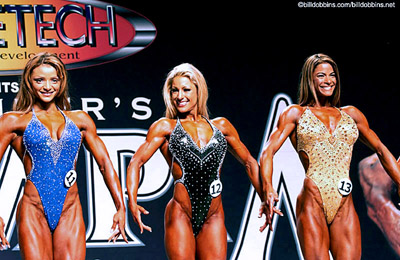 compact. When
it comes to figure, genetics is tyranny.
compact. When
it comes to figure, genetics is tyranny.
But of the figure competitors with that "ideal" figure look is Amber Littlejohn. Amber has such long proportions that she looks like one of those idealized , stretched-out bodies drawn by fashion designers. Amber placed fifth and could win this contest eventually if she puts on more muscle. Muscle on Amber will never make her look "bulky" but she needs to have at least as much muscle and definition as Davana and Jenny and maybe a little more. At one point Amber claimed that getting somewhat bigger was her goal, but she hasn't made any progress in the past year or so.
Get back in the gym, Amber. You could easily be Ms. Figure Olympia in time if you put in the work.
Two women who have placed well in the past but did less well this year were Mari Kudla-Donnelly and Elaine Goodlad. This is what I meant by the "shake out" as the judges begin to vote more consistently for that leggy model look. But in spite of not quite having the required genetics, both Mari and Elaine are spectacular looking women. Mari looks like an athletic sex kitten (move over Anna Kornikova) and Elaine could be one of the most attractive pro bodybuilders if she had chosen to compete as one.
But even though you can't change your genetics, which makes improving in figure difficult for many, my advice to both these women, Monica and others is simple: work at getting in your best possible shape, which includes being hard and defined at the body weight that give you the best symmetry. Whatever they tell you, figure is still a physique contest and showing up soft and lacking definition is never a good idea. Being in shape won't win you a contest but it can definitely hurt your placing. Even if the judges for some reason happen to reward you for looking like this a time or two, it will not serve you well in the long run.
AFTERWORD
ONE-PIECE/TWO PIECE SUITS
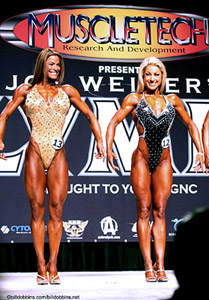 Just as I don't like
the cat-suit round in fitness, I am opposed to having two physique rounds
in both fitness and figure featuring different
kinds
of suits. Since physical development and conditioning is an essential
part of both types of competition, why cover up the torso of competitors
by a one-piece suit? The IFBB says they include both rounds because
different women look better in one kind of suit than the other. That's
exactly the problem! The one-piece suit is designed to cover up faults
and weaknesses that wearing a bikini reveals. Why on earth would
you have an IFBB or NPC contests, both of which are essentially bodybuilding
federations, in which you allow competitors to cover up faults to hide
them from the judges?
Just as I don't like
the cat-suit round in fitness, I am opposed to having two physique rounds
in both fitness and figure featuring different
kinds
of suits. Since physical development and conditioning is an essential
part of both types of competition, why cover up the torso of competitors
by a one-piece suit? The IFBB says they include both rounds because
different women look better in one kind of suit than the other. That's
exactly the problem! The one-piece suit is designed to cover up faults
and weaknesses that wearing a bikini reveals. Why on earth would
you have an IFBB or NPC contests, both of which are essentially bodybuilding
federations, in which you allow competitors to cover up faults to hide
them from the judges?
It's also a fact that there are just too many quarter turns in a figure/fitness event. This gets very boring. And it's worse on the amateur level where you have so many height divisions. How long can an audience watch dozens of women do quarter turns before they tune out entirely?
Let the women compete in just the two-piece round and give everyone a break.